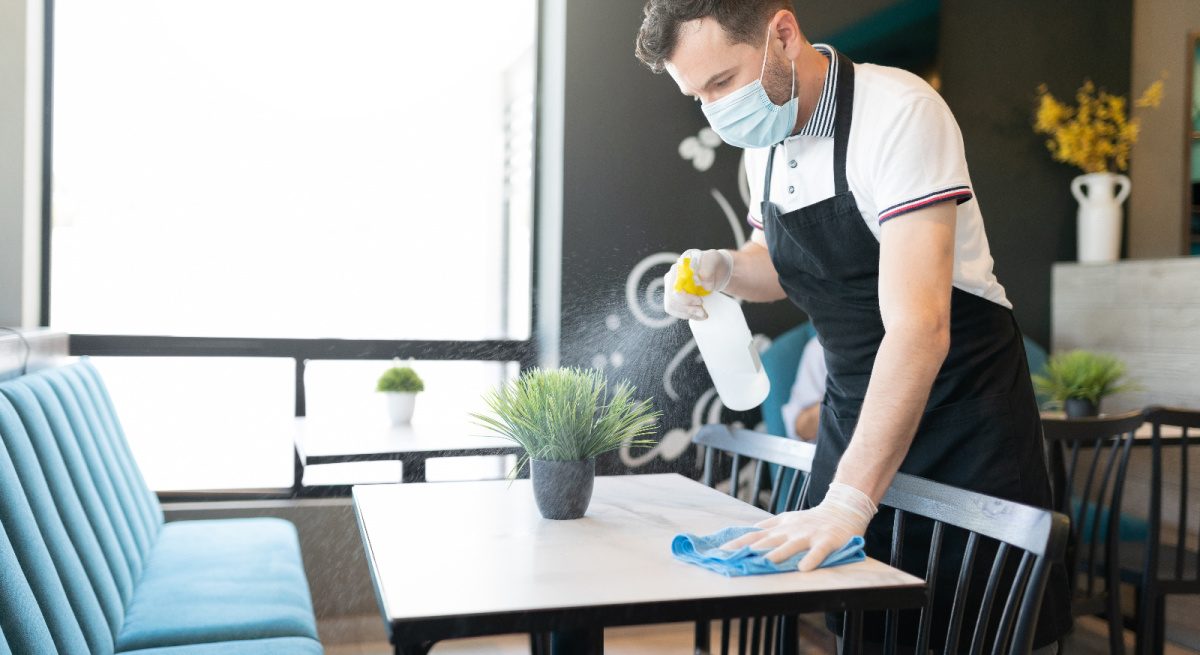The New Era of Restaurant Cleaning and Hygiene
5 Min Read By Brant Insero
Hygiene and cleanliness often go hand in hand, but adoption and follow-through with measures like disinfection, handwashing, and hand sanitizer use within commercial facilities were not as consistent prior to the COVID-19 pandemic. Without the widespread threat of infection, cleaning was previously more focused on appearance than protecting public health and was not as strategic as it needs to be today.
The pandemic has made it clear: restaurant guests demand cleanliness, and this new emphasis is here to stay. Now, restaurant owners and managers can be confident in their readiness against pathogens and reassure guests and employees by committing to cleanliness and effectively communicating their approach to the public.
Building Trust Through Cleanliness
Throughout the pandemic, many restaurants have faced the challenge of restoring trust and assuring guests they’re doing everything in their power to keep them safe and healthy. According to PwC, consumers are most influenced by their trust in a brand, which also includes places where they’re sure of safety and cleanliness. Thus, restaurant owners must prioritize cleaning, disinfection, and infection prevention to give customers peace of mind.
In addition to considering their customers, restaurant owners must also take the necessary steps to reassure and retain employees. A recent survey found only 14 percent of employees around the world are confident in their CEO’s and management’s leadership regarding return-to-work policies. For those employees that have already returned to work, 42 percent said safety measures enacted by management were either ineffective or not strictly enforced.
Some companies have even spent upwards of $1 billion on personal protective equipment (PPE), cleaning procedure trainings, cleaning and disinfecting products, and other pandemic-related costs. During the height of the pandemic, it seemed necessary to invest in every strategy and solution. However, as we learn more about the way SARS-CoV-2, the virus that causes COVID-19, spreads, we uncover that some of these measures can play into ‘hygiene theater.’
Hygiene theater is the act of increasing hygiene protocols that may make customers feel safe, but don’t correlate to lowering the risk of infection. Restaurant managers should assess whether the cleaning procedures they’ve adopted at the onset of the pandemic still serve their needs and their stakeholders’ needs.
Communicating Cleanliness
Communicating new or revised protocols and safeguards to both customers and employees is extremely important. A recent report uncovered that nearly 9 in 10 (88 percent) consumers take note of the cleanliness of businesses they frequent often. Furthermore, 86 percent of consumers would ideally like to see proof that public places such as restaurants, offices, businesses, gyms, or schools are cleaned on a regular basis.
Employees also worry about the level of cleanliness at their workplace. One survey uncovered that over half (60 percent) of people would leave their current role for a lower paying, healthier work environment. In fact, it’s become quite common for people to ask potential employers about health and hygiene practices. Therefore, restaurant owners must properly communicate protocols and expectations amongst internal and external audiences to ensure everyone feels as safe as possible when visiting or working in the facility.
What Can You Do Now?
Restaurant managers can consider the strategies below to uphold cleanliness and highlight their restaurant’s commitment to public health and safety, without falling for the trap of “hygiene theater.”
- Outline cleaning procedures and frequencies. The Centers for Disease Control and Prevention (CDC) recommends fully cleaning and disinfecting a facility where a person has tested positive for COVID-19 within the last 24 hours. However, when it comes to everyday cleaning, large scale disinfecting isn’t always necessary. It’s best to develop a plan based on the types of surfaces and high-touch areas within the facility and then educate cleaning teams on when, what and how to clean and disinfect them properly.
- Provide staff and patrons with PPE and hygiene essentials. Patrons may forget to bring a mask every time they visit your business, especially with mask mandates and recommendations in different states and cities shifting as cases of the variant rise and fall. Have disposable masks on hand for all, as well as gloves for employees. Also, regularly check the stock of hand sanitizer stations that are strategically placed near entry and exit points.
- Implement digital signage and contactless payment technology. The digital signage market has seen exponential growth in the last year. Some businesses have been able to use it to provide employees and guests with safety measures in real-time, including maximum capacity alerts, social distance flows, and even how-to guides for PPE.
Meanwhile, upgrading to digital point-of-sale (POS) systems for contactless payment at checkout will resonate well with consumers. Nearly 3 in 4 customers agree that it’s important for a business to offer touchless payment options.
- Re-evaluate cleaning chemicals and technology. Often, employees use more cleaning product than necessary. Consider systems that help to minimize waste and maximize sustainability. Larger restaurant owners may also want to invest in electrostatic sprayers to disinfect surfaces effectively and quickly. To improve indoor air quality, use vacuums that utilize HEPA filters that remove dust particles, allergens, and pathogens, and assess whether the chemicals you are using to clean and disinfect are free of fragrances, preservatives, and other additives that may irritate employees or guests.
- Make cleaning visible. Have employees clean and disinfect during operating hours. This is a great way to provide patrons with a sense of security, as they can see cleaning take place. For tougher jobs like entrance and kitchen mat cleaning or mop head sanitization, consider partnering with a third-party service provider that can take care of these tasks on a regular basis. Seeing these cleaning professionals in your restaurant will reassure customers and employees that you take cleanliness and safety seriously.
- Implement color-coded cleaning solutions. Color-coded products can include mops, microfiber cleaning cloths and even plastic bottles that help employees differentiate cleaner from disinfectant or sanitizer. This is an easy step to make sure surfaces are effectively cleaned and that there is no cross contamination between restrooms, dining areas, and other common spaces.
- Invest in proper training and certification. Take the time to train staff on how to perform cleaning tasks and properly utilize specialized cleaning equipment to save time and money while also reducing the risk of injury. Consider committing to an accreditation process that will help you prepare for, respond to, and recover from biorisks to assure employees and guests that your business has a strategic cleaning, disinfection, and infection prevention program in place to keep them healthy and safe.
Tackling Today’s and Tomorrow’s Pathogens
When it comes to implementing any new or revised cleaning and hygiene procedures, communication is key to providing peace of mind to guests and employees. On top of discussing and showcasing cleanliness, restaurant owners and managers must follow through and enforce enhanced cleaning procedures. Ultimately, it’s up to business leaders, in-house cleaning teams, and outsourced cleaning service providers to hold each other accountable so that today’s and tomorrow’s infectious disease risks are effectively and efficiently managed.


